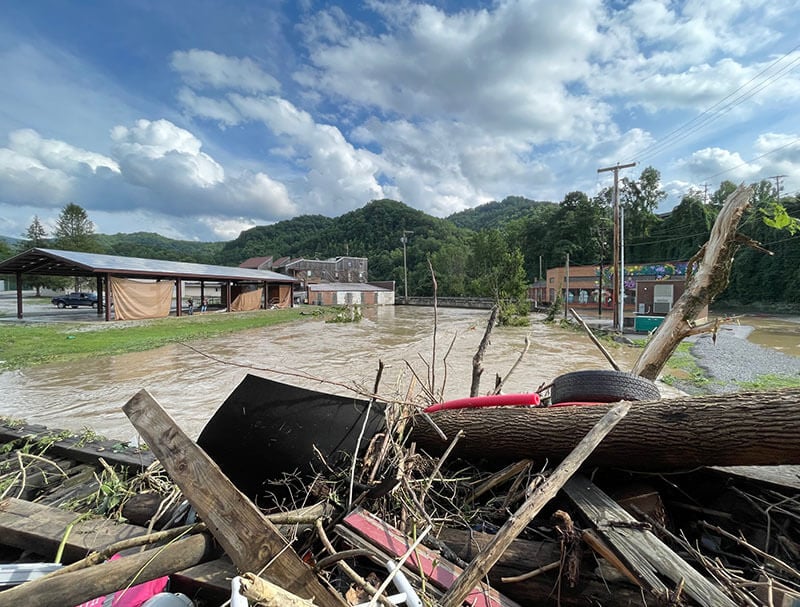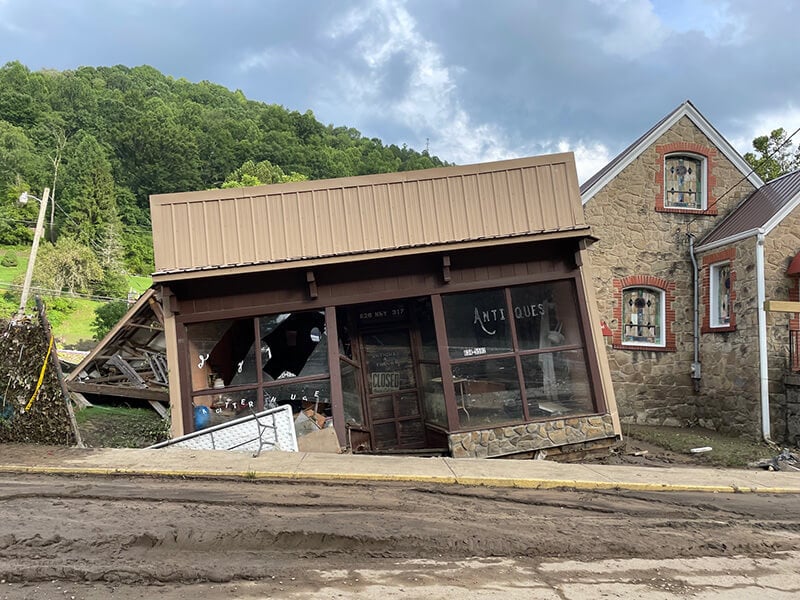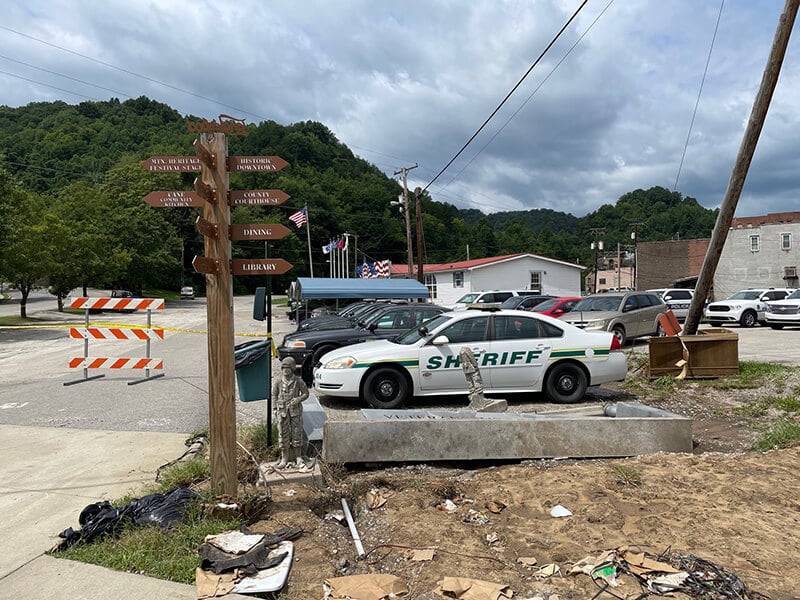Flooding in the Sacrifice Zone

Last week I gave a ride to a guy named Chris who’d been helping out with flood relief in the town of Neon. Chris lived about two miles down the road from Neon, next to an abandoned carburetor shop that was now wrecked by floodwaters. His house had miraculously escaped destruction. But the trailer homes at the bottom of the hill were all gone. In their place sat a solitary shed, mostly intact and settled comfortably into the mud like it now owned the place. It had floated all the way downstream from Neon on the Kentucky River—two entire miles. That really confused the hell out of us. We pondered it for at least ten minutes. Two miles, and the thing was still intact? After all, there was a large bridge between where it once sat and where it now sat—so how did it clear that bridge without taking any damage? We had all kinds of ridiculous theories. Maybe it had gotten sucked under the bridge and popped back out the other side? Maybe the owner had moved it the week before the flood? Eventually we landed on the most obvious explanation, the one we’d been trying to avoid: the floodwaters had simply drowned the bridge itself, briefly transforming it from an active piece of infrastructure to a deep-sea relic. Once we got to that point, we sort of had to stop and sit in silence. Before, the truth had been too grim to accept; now, it seemed perfectly logical.
In the wake of Eastern Kentucky’s catastrophic “Flood of ’22”—potentially the deadliest on record, once all is said and done—there’s been no shortage of questions, theories, and even hazarded answers. Here’s one example, offered to me by a stoic or perhaps Buddhist power company worker in line at the gas station: I’ve been searching for all kinds of answers as to why this happened, and finally I realized that maybe we aren’t meant to know. Another was offered by Kentucky’s credulous Democratic governor, Andy Beshear: I wish I could tell you why we keep getting hit here in Kentucky. I wish I could tell you why areas—where people may not have that much—continue to get hit and lose everything. I cannot give you the why . . . . And yet another, from the thousands of impacted residents and activists around the world watching in real-time as the environment transforms into a permanent state of emergency: it’s the climate, stupid.
People are angry, and that rage can be harnessed toward a story, a collective narrative.
But even asking the political question at a time like this is difficult, thorny; it can seem callous. In the wake of a natural disaster, people tend to put emphasis on that qualifier natural. One young couple came into the makeshift mutual aid office some friends and I had set up in Whitesburg and told me about some particular political answers they’d been hearing. They had lost everything: their home, their pets, even their car (but they only lost the car after the flood, when they unknowingly filled up the tank with gas that had been polluted by floodwaters). They were two of the angriest people I’d met so far, four days in—most people were still shocked, rendered inarticulate by the power of the universe to fuck them over so badly. What they were mad about wasn’t surprising, but only because I’d heard it so many times before: people—probably in the cities—were saying that We Deserved This Flood Because Of The Election. The couple didn’t seem to have an affiliation one way or the other, but they were sure as shit enraged at the insinuation that they’d brought hell upon themselves because they hadn’t stopped their neighbors from voting for Donald Trump.
In a true sign of the times, the Lexington Herald-Leader’s op-ed section tried to discourage this kind of victim blaming, writing, “We can rally to help [Eastern Kentucky] without worrying about politics.” But while well-intentioned, this, too, misses the point: we have to be able to discern where the natural part of any disaster ends and the social or political part of it begins. After all, as the young couple showed, people are angry, and that rage can be harnessed toward a story, a collective narrative, that would help us prevent this from happening again.
But what is that story? To tell it, we have to take a step back and look at the disaster itself, the years leading up to it, and the minutes and hours that came after. Marx famously said that men make their own history, but not under conditions of their choosing. The same can be said for natural disasters. When several complexes of “training thunderstorms” established themselves over Eastern Kentucky on July 25, pounding the Kentucky River watershed with upwards of fourteen inches of rain over the next five days, the conditions were ripe for a catastrophically fatal outcome. First of all, the Kentucky River watershed had been subjected to many decades of strip mining, which decreases the soil’s ability to retain water. So, when the rains came, the water was funneled into creeks—and peoples’ homes. There’s a reason Knott County has had the highest number of flooding fatalities: its narrow valleys created virtual traps in the face of rushing water, pinning people to the ground at the exact moment they needed to be anywhere but.
The aforementioned Neon is the best example of what this looks like. Just a few miles upstream from it is an old strip mine. When the water came through that area, it ran through the community like a stampede of bulls. Neon is now a wasteland of twisted metal. There are cars in houses, houses on top of houses, an entire building unmoored from its foundation. City Hall has had to set up in a muddy parking lot under a pop-up tent and a camper van. Even further upstream from Neon, in a community called McRoberts, I saw something I’d never seen before: two cars freestanding end-to-end on a bridge rail, completely mangled and disassembled but perfectly preserved in their disassemblage, like they’d been pinned to something larger while the water stripped them apart, piece by piece. It now remains like a statue, a testament to the power of deluge.

Again, all this water had to go somewhere, and that’s why Breathitt County has had the second highest number of fatalities: it’s near the confluence of both the North and Middle Forks of the Kentucky River, right where the mountains start exchanging with the bluegrass. This area has also been extensively mined, and like every other county in the Kentucky River watershed, it is extraordinarily impoverished, which is another crucial precondition for the recent storm’s barbarity. A lot of hay was made over a Joel Pett cartoon in the Lexington Herald-Leader that commented on how the flood had absolutely hammered the region’s poor people. The main objection seemed to be that Pett was neglecting the damage done to the rich, or, worse, that he was—gasp—portraying the region as impoverished in the first place. But the fact of the matter is that this is one of the poorest watersheds in the United States.
At one point in recent history, more than one fourth of Knott County was owned by major coal companies. People were forced to work sixteen-hour days in the mines, their communities’ already-fragile infrastructure was worn down by prolonged resource extraction, their lives and housing and job options were reduced to Victorian-era levels of proletarian scarcity, and not even Lyndon Johnson’s War on Poverty was going to turn that around. Go to Neon, Knott County, Breathitt County, today, and witness the class war. Even before the flood, it looked like what they call natural disaster, all the time, every day.
The poor and working people of this part of Kentucky also live in social environments that are heavily policed. Many are addicted to substances that were forced upon them by pharmaceutical companies at a moment of extreme regional crisis—the organized abandonment of the coal industry. You saw how this aggressive policing played out in the hours after the flood. While everyday people braved the storm to help out their neighbors—I heard a story about one Whitesburg City Hall worker named Red, who never learned to swim but managed to rescue twelve people from their homes using an old kayak he found—the cops were already practically salivating to shoot looters. The Letcher County sheriff said he was going to “limit these dirtbags” and “make a damn example of them.” Never mind the fact that many of the area’s roads were still inaccessible at this point, leading one to the logical conclusion that he could only be referring to flood pirates.

Meanwhile, the people I’ve seen and talked with have been in no condition for looting, either physically or mentally. Everyone, rich and poor alike, is wearing that vacant face you see boxers get after taking a hard one to the jaw. This didn’t stop the sheriff and Whitesburg city police from bringing in a humvee and cruisers from at least six different regional municipalities, enforcing a curfew from midnight to 6 a.m., and towing out flooded cars from downtown without notifying the owners, then making them pay an impoundment fee. The cops’ actions infused a situation already rife with fear and paranoia with even more fear and paranoia, when what people really needed was safety and freedom of movement. This immediate rush toward a law-and-order crackdown is probably as good a harbinger of the new climate-crisis paradigm than any other thing I’ve witnessed.
But you don’t have to look hard for other examples. Every government institution, from top to bottom, has seemed content to sacrifice poor and working people one by one. As soon as the flood hit, Eastern Kentucky’s communications infrastructure buckled under duress, leaving people isolated and alone for hours. More than twenty-three thousand lost electricity. Roads and bridges have collapsed, leaving entire communities inaccessible. Others, like Neon, are without running water and waste disposal, and it may be months before this can be fixed. While President Joe Biden declared the flood a major disaster on July 29, it was another two days before the state’s first FEMA mobile registration center opened to help residents access relief; additional centers did not reach Knott, Breathitt, and other counties until August 2. You can easily talk yourself out of criticizing this delay until you concede that, yes, OK, we do live in the wealthiest, most technologically advanced society in human history, so surely something else must be going on here.
In the absence of meaningful state intervention, we have seen citizens springing to action to help each other out, providing direct aid in the form of supplies, money, and labor. But even aspects of this mobilization can feel of-the-minute and hopeless. How do you sit staring at pallets of bottled water as far as the eye can see while also ruminating on the thousands of gallons of oil that reportedly washed down the Troublesome Creek in Hindman after the floodwaters busted a gas station tank? A friend and I joked that it was briefly the most expensive stream in all of Kentucky. I guess all you can do sometimes is laugh.
Even before the flood, it looked like what they call natural disaster, all the time, every day.
The fact is that what the people of Eastern Kentucky need more than anything—more than church group volunteers and sympathetic liberal donors from California and people waxing poetic about the National Guard—is transportation, shelter, and money. And that’s one thing to look at in the coming months and years, as politicians make gestures toward rebuilding. You hear this word a lot, rebuilding. Will Governor Andy Beshear stand by his promise to do “everything we can”? That depends: Is he, along with the rest of the Democrats, prepared to construct free and efficient housing for the thousands of people displaced by this flood? We already know the answer. For the Democrats in rural areas, just as much as for the Democrats in urban areas, you do not fuck with the property relation. Homelessness and “visible poverty” have recently become flash points for reactionary liberal politics—see Chesa Boudin’s recall in San Francisco—for this very reason. You can give out all the canned goods and flashlights and diapers in the world, but once you start talking about giving people free housing, about creating a collective administrative state that ensures the communal ownership of property—well, then, all bets are off.
The irony is that for years before the flood, Eastern Kentucky had already been engaged in a process of rebuilding. It was called the “just transition,” and its goal was to rejuvenate the region through entrepreneurship, innovation, tourism, and public-private partnerships. That dream is now dead for the foreseeable future. It’s why I suspect that this newest iteration of rebuilding will become, like the old one, a kind of farce. Why would anyone want to rebuild the same society that let this happen in the first place? Besides, it’s the unspoken truth on everyone’s mind that what people like Beshear mean by rebuilding amounts to burdensome bureaucratic paperwork, insufficient or rejected requests for insurance payouts, perhaps some downtown beautification projects here and there, and mayors and congressmen rubbing shoulders with governors to clinch grant handouts. Meanwhile, all you have to do is look at the sluggish recovery of Western Kentucky after the devastating tornadoes of last year and observe for yourself: rebuilding is just the hot new buzzword for running out the clock until the next disaster hits—at which point you can start the same cycle all over again.
This all became clear to me as I helped an exhausted woman load up her car with toilet paper, food, money, and cleaning products. It was maybe the fourth or fifth day after the flood, when Letcher county had begun to see a new kind of inundation: crisis workers with NGOs from out of town. It was blisteringly hot, and we were remarking on the haze in the air, a product of all the mud caked on the streets drying into dust and getting kicked up by cars and National Guard humvees. At some point, the woman looked at me with a face that had seen a thousand years in a weekend and said, Well, I guess we at least made history. Like I said, all you can do sometimes is laugh.